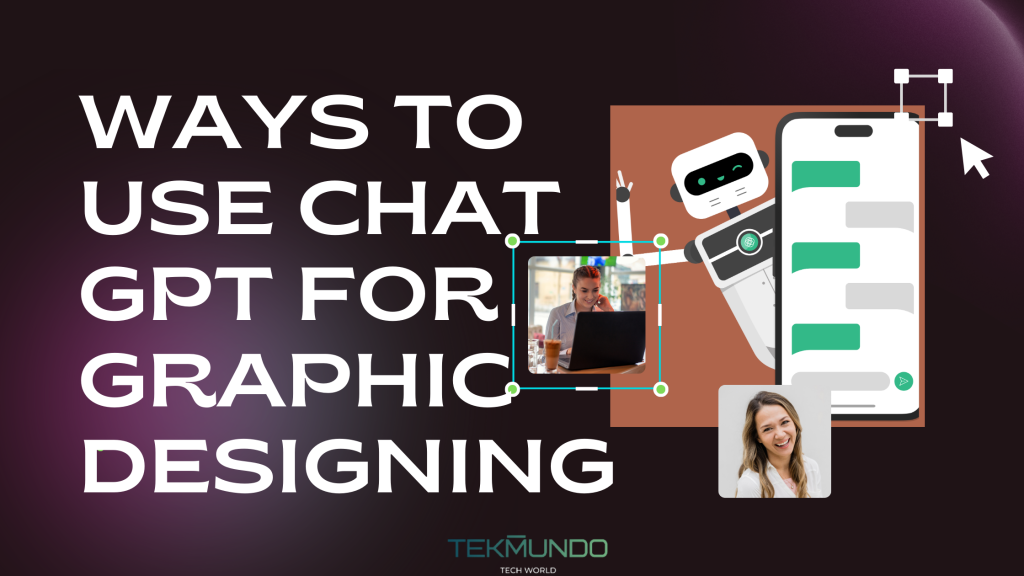In the present era, AI (Artificial Intelligence) is pushing the boundaries of possibilities in various fields, and graphic designing is no exception.
One of the most groundbreaking AIs in recent years, Chat-GPT, has emerged as a versatile tool for both novice and experienced designers.
You might wonder, “How can a text-based model help with visuals?” Well, let’s dive deep into ways to use Chat-GPT for graphic designing! Chat-GPT, developed by OpenAI, is a conversational AI model based on the GPT architecture.
While primarily known for its text-based capabilities, with the introduction of image input capabilities, it offers a unique intersection of language and visuals, making it a valuable tool for designers.
The ChatGPT Magic for Graphic Designers
ChatGPT can particularly help graphic designers with six tasks. These are:
1. Concept Brainstorming
Before any design exists, there’s a realm of thoughts, sketches, and ideas—a process commonly known as brainstorming. Chat-GPT offers an interesting twist to this traditional practice.
- Idea Generation:
At times, creative blocks can hinder the flow of ideas. Describe your project’s objectives, target audience, and the emotion you wish to evoke to Chat-GPT. It can provide you with innovative and unique design concepts tailored to your requirements, acting like a virtual brainstorming partner.
- Feedback:
Once you’ve come up with some preliminary ideas, share your concepts with Chat-GPT. It can critically analyze your ideas, offer feedback, suggest improvements, or even provide you with an alternate perspective that you might not have considered.
2. Color Palette Suggestions
Color plays a pivotal role in design. The right combination can convey emotions, create a brand identity, and much more. But how do you pick the perfect palette?
Simply describe your project’s mood, theme, or even a situation to Chat-GPT. Depending on the context, it can offer multiple color palette suggestions.
For instance, if you’re designing a poster for a meditation retreat, Chat-GPT might recommend a calming palette with shades of lavender, soft blues, and pale greens, emphasizing tranquility.
3. Typography and Font Recommendations
Typography is often said to be the voice of design. It communicates the message while also influencing the perception of the brand or product.
Given a brief about your project, Chat-GPT can recommend a set of fonts that not only align with your design’s theme but also ensure readability and aesthetic appeal.
Whether it’s a vintage look or a modern minimalist vibe, Chat-GPT has insights on font pairings and typographic treatments that can elevate your design.
4. Inspiration from Historical and Modern Designs
History often offers a treasure trove of inspiration. Chat-GPT, with its extensive database, bridges the gap between the past and present in design.
By querying specific eras, styles, or even design movements, Chat-GPT can suggest elements, patterns, or techniques that can be integrated into your designs, offering a unique blend of vintage charm with modern flair.
5. Translation and Localization
In our globalized world, designs often cater to a diverse audience. This requires sensitive and accurate localization.
Provide Chat-GPT with your content, specify the target audience’s language or region, and it can assist in translating or localizing your content.
This ensures that your designs are not just visually appealing but also linguistically accurate and culturally resonant.
6. Interaction with Image Input
Chat-GPT’s capability to interact with images amplifies its potential in the design domain.
- Work-in-progress feedback: By showing your designs, you can get real-time feedback, suggestions on color adjustments, layout modifications, or even element placements.
- Visual Inspirations: Describe a theme, mood, or even a vague idea, and Chat-GPT can provide visual inspirations or references to help guide your creative process.
Stats Spotlight
Here are some stats that might surprise you:
Figma:
- Witnessed over 4 million users by September 2021.
- 150% increase in fundraising YoY (Q2 2020 to Q2 2021).
- Organic presence up 115% YoY (June 2022 to June 2023).
- 355% increase in brand awareness (June 2021 to June 2023).
Adobe:
- Adobe XD reported over 3 million users by September 2021.
Organic search keywords for Adobe showed:
- 32% YoY increase.
- 80% increase in 2 years.
- 886% increase over 7 years.
Sketch:
- More than 1.5 million active users by September 2021.
Organic presence growth:
- 7% YoY.
- 49% increase in 2 years.
Axure RP:
Organic performance dropped:
- 3% YoY.
- 29% from 2 years prior.
Framer:
- Over a million users by September 2021.
Funding raised showed:
- 267% increase from 2017 to 2018.
- 81% growth from Q1 to Q3 of 2023.
- Organic performance increased 98% from 2 years ago.
InVision:
- Over 7 million users by September 2021.
- Fundraising was up 48% YoY from 2017 to 2018.
Organic presence decreased:
- 26% YoY.
- 52% from 2 years prior.
Proto.io:
Organic performance:
- Down 15% YoY for 2023.
- 49% down from 2 years prior.
Canva:
- Over 60 million active users by September 2021.
- Fundraising doubled from Q1 to Q2 of 2021.
Organic performance:
- Up 65% YoY.
- Up 106% from 2 years prior.
Conclusion
While traditional design tools remain invaluable, the integration of AI, particularly Chat-GPT, offers an innovative approach to graphic designing.
From brainstorming to final touches, it’s evident that there are myriad ways to use Chat-GPT for graphic designing. As the realm of AI and design continues to evolve, embracing these technologies can give designers a creative edge in an increasingly digital world.






